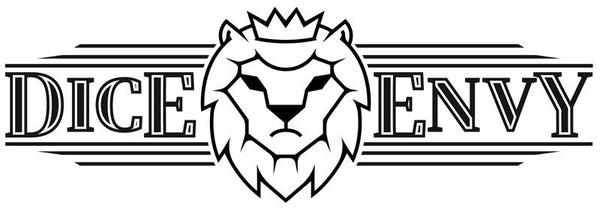D20 Dice

A twenty-sided die is called a d20. These are the most frequently rolled dice in many games like Dungeons and Dragons (D&D) and many similar tabletop roleplaying games (TTRPGs). Each side of a D20 represents a 5% chance for 20 different degrees of success or failure.
Some of the game’s most memorable moments are triggered after rolling a natural 20 to make a critical success, or a natural 1 resulting in a critical failure. Either result on your 20-sided die result can make for an outstanding collective story told by your gaming group.
Only dice found in our customizable sets can be ordered individually. Quiddie is the one featured above.
For single d20s
Common D20 Dice Roles in Dungeons & Dragons
- Rolls for Initiative - This is the roll at the beginning of combat to determine the turn order. The player characters with the highest rolls get to take their turns first.
- Skill Checks - Everything from your success making a backflip (acrobatics) to your chance to successfully tell a lie (deception) is determined with a D20 dice roll. If it beats the difficult check (DC) of the task, then it succeeds.
- Attack Rolls - When your character swings a weapon, you’ll roll a d20. If the result is higher than the armor class (AC) of your target, then the attack is a hit and you get to roll more dice to determine the damage you do.
- Saving Throws - Anything from dodging a fireball to shrugging off mind control, to keeping your liquor down. Roll a D20 to determine whether you’re able to avoid damage or a harmful effect.
An Iconic Shape
20-sided dice have a rich history. Archeological evidence shows d20 dice being used in ancient Rome, Greece, and Egypt. Can you imagine playing with a dice set over 2000 years old? Such a cultured die deserves our greatest respect. The roots of D&D may even go back further than 1974.
20-sided dice a shape called an Icosahedron, the name for a twenty-sided polygon. Even just the shape is iconic of Dungeons & Dragons. When you see it on t-shirts or made into earrings, you just know you’re talking to a role player.
Watch out when rolling your d20. Because 20-sided dice are the most spherical of your set, they’re the most likely to roll off the table.
Some players prefer a D20 that’s a bit larger than the other dice in their set. We lovingly refer to these as chonky d20s. Because they’re rolled the most often, the bigger d20s are easier to find when you’re asked to make an unexpected roll.
The D20 in Action
You’re infiltrating the castle of an evil vampire lord, his zombie guardsmen are everywhere. Make a stealth check to avoid detection using your 20-sided die. You roll a 16 pretty good.
You were able to give most of them the slip, but one of them rolled an 18 on its perception check. It catches the sound of your trailing footsteps and follows you the edge of the battlements. It locks eyes with you - get ready to fight!
Roll initiative. The zombie’s roll of 11 beats your roll of 4. It strikes first with an attack roll of 15, but your armor class (AC) is 16, and the zombie’s claws scape harmlessly against your armor.
Your turn. You roll your d20 dice and get a natural 20, a critical hit! Now you can roll a die for damage determined by your weapon. And because it’s a crit, the damage is doubled. You cut the zombie’s head clean off, and it falls over the edge of the castle walls. You retreat to the safety of the shadows before any of its buddies catch sight of you.
A d20 die was used in 5 out of the 6 rolls used in this scenario. Your weapon’s damage was the one exception. You can imagine how the story would have turned out completely differently if the results of the dice roll were different. That’s the power of 20-sided dice in D&D.
Some dice sets even feature two d20s. These are helpful when making rolls with advantage or disadvantage to represent how circumstances can affect the probability of your success. When rolling for advantage, you’ll roll two d20s and take the higher result. It’s the opposite for disadvantage.

The Full Set
A full D&D dice set has at least one d20, d12, d10, d8, d6, d4, and d%. (The d% is another d10. Two d10 are rolled together to get a number between 0 and 99.) Each die in a set is used depending on the probability of different effects, or to calculate the range of damage by different attacks and spells.
If you’re preparing to play D&D for the first time or shopping for a D&D player you love, order d20 dice as part of a complete set. Dice Envy products are made from cool materials like polymer resin, wood, stone, and even metal. They’re highly collectable, great to show off to your friends, and you can never have enough neat different sets.
Order with Dice Envy
Here at Dice Envy, we have many d20 dice sets. The d20 dice is an essential piece for any tabletop game; indeed it is impossible to play D&D without this die. Whether you’re looking to get a dice set made from metal or wood or stone, we have options available to suit your tastes and even the theme of your character. Now let the games begin!
